|
- Children's
Games -
The image above is shown wth
the permission of Bill Bullock
The Pink Bank Lane
Cycle Track 1956? Photograph donated by Shelagh
Street. Actually,
Larry,
the lad on the bike, gave up his cycling career to go,
on scholarship, to Cambridge before becoming a nuclear
physicist in the U.S.A.
*********************
I read recently that a major study of the UK media had found that "children in the UK have developed a television and bedroom culture because their parents are too worried to let them play outdoors." "Half of six and seven-year-olds in the UK", the study found, "have televisions in their bedrooms, nearly three times as many as French or German children. They spend an hour a day more watching television than their continental counterparts. In total, the study found children spent an average of five hours each day watching TV, playing computer games, listening to music or on the Internet." Well, in the 50's when I was growing up in Manchester only a few houses had TVs and of course no one had computers and the Internet was still a long way off for home access. Not only did kids not have their own TVs but very few of them had their own bedrooms in which they could hide-away. But more importantly for the kids of the 50's the street was the "playstation." We spent each day out on the street with all the other kids and I don't think our parents worried that much about our safety. In fact even on rainy days I remember lying on the floor with the front door open shouting across to friends in adjoining houses just waiting for the rain to end so we could get outside. It wasn't very often that anyone was daft enough to let us have friends to play over. I do remember though playing next door at my friend Lynda's house. On stormy days I loved to play there because Lynda's mom was always worried about lightning. She reckoned that if a thunder bolt hit it would roll right through the house if you opened all the doors to let it get in and out, so she always had the front and back doors wide open just in case. She was lovely lady. The games that children played were of course seasonal, reflecting the realities of the climate, but they also tended to mirror the fascinations of the time. So cricket and French cricket were popular in the long summer holidays that in those days lasted for years. Whereas footie in its many forms was battled out between the reds and blues in the dying light of autumn and winter between the escape from school and "Come on our David it's time for bed, I'll not tell you again!" Gender was also obviously a factor in the games we played. It's not PC to say that sort of thing these days, but it was true then. There certainly were times when we all played together in a huge game of kick-the-can or hide-and-seek or even hopscotch but the girls didn't usually get to play footie and, speaking for myself, I was never up to the highly technical games of skipping or the tricks they could do juggling 2 or 3 balls at a time while spinning around or putting one hand behind their backs. The best I could do was have every girl on the street laughing at me trying to retrieve 3 tennis balls from under a car. Now I'm no expert
on this children's play thing. My only qualification
is that I was one once but that was a long time ago
and my memory is fading fast. However, I'm going to
take a shot at this because I think that in the play
of kids we get a sense of the culture of a period. If
anyone out there wants to add their own two penneth
please feel free. *************** 
Images courtesy of Mia Levesque and Don Olney Whip and tops were not year-round toys. It seemed as though all of a sudden they were in the shops and everybody had them. Then people would get sick of them and lose them before next year. This really was a game of skill that some kids mastered and others were just hopeless at. The tops were stout little wooden cones with a metal stud at the base on which they would spin if you did it right. The whip was a stick with a heavy cord attached. You wrapped the cord around the top and then steadying the top with one finger you pulled the whip quickly unwrapping the cord and sending the top dancing across the flags. Some people could hold the whip and top in one hand and launch them in mid-air. To add to the effect we would go to Bill's, the corner shop, and buy a box of coloured chalks and make a design on the top of the top so that when it spun the colours would appear to mix and once again some kids preceded Andy Warhol as pop artists. Don Onley is the
owner of "The Toycrafter" a small manufacturer of
wooden toys located in Rochester, NY. He collects all
kinds of spinning tops, peg tops, gyroscopes, and any
other top related items such as items with spinning
tops in the brand name and logo, books about spinning
tops of all sorts, etc. His toys are available in
hundreds of gift and toy shops around the world. Don sent me the following description of how to use a whip top:
One of the skills
to acquire after you can keep it spinning is the art
of lifting the top and depositing it in a different
(planned) location on each whip action. At just the
moment when the top is fully wrapped on each swing, it
is lifted - spin added - and thrown to a new spot. A
skilled person can actually "walk to school or the
store propelling their top along with them." ***************************  This photograph is taken from Street Photographs: Manchester and Salford by Shirley Baker (Bloodaxe Books 1989) It is displayed here with the permission of the photographer Having
chalk
to colour your top often spawned other uses for the
chalk and this included hopscotch but it also
included drawing on the flags. Kids played school
drawing lessons on the pavement for other kids to
follow but it was usually primitive art work that
spread across the "fronts" of houses. Now of course
this wasn't always popular with the woman whose
"front" it was and this activity often spurred them
on to swill down the flags outside their house
destroying the latest art exhibition.
********************
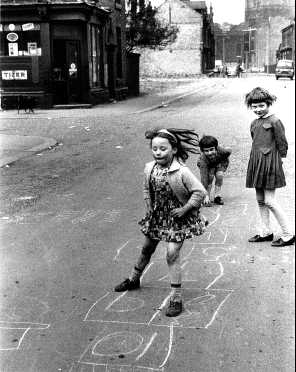 by Shirley Baker (Bloodaxe Books 1989) It is displayed here with the permission of the photographer Another
chalk related activity was hopscotch. Whilst
this was a unisex activity it was the girls who
ruled because it was the girls who knew the
rules. If there was any constant in street play
it was that most games had rules and hardly ever
was there agreement on what those rules were and
there was never full compliance on the
application of the rules. So girls always had
the upper hand. First of all they were better at
the skills like hopping with enough control to
advance the tin can to the next numbers. they
had smaller feet and rarely touched the lines
and they knew the rules and since they were
never written down it was hard to prove that
they just changed them to suit the situation.
Hopscotch was one of those games that could go
on for hours. Now I think about it there were at
least two kinds of hopscotch. The regular one
where you threw a small flat tin, like the ones
throat lozenges came in, or a stone, to a
number, hopped on the numbers skipping over the
number in question, going on to the end turning
around and coming back picking up the can on the
way back. There was another variation though
where the hopper moved the can to another number
with the hopping foot. The layout of the
numbered blocks was another variation because
there was the layout with the half-moon top and
another that was completely rectangular. *********************
I always thought this was Kitcan because that was how we said it. Now I don't think it was in the rules that you had to play kick-the-can in the evening but I don't remember ever playing it any other time. First of all I remember it going on until dusk and beyond and I also remember getting dragged in to go to bed with it still going on and having to lie on my bed in the front bedroom listening to all my friends still out there having fun. Now the other thing is I never remember having a can to kick, we used a football. Basically it was a form of hide and seek. A ball was placed in the middle of the street and someone was "it". Everyone else had a count to 100 or whatever was decided to go hide usually down the back entries squished in by the backyard gates, in the spaces between the bay windows on New Bank Street, behind cars or lorries, that sort of thing. There was usually an agreement on just how far away you could go to hide. Then the person who was "it" sought out the others. Unlike Tick, you didn't need to touch them just point them out and run back to the ball and touch it with your foot thereby capturing the kid in question. When caught, the kid had to return to the location of the ball while the person who was "it" tracked down the rest. Where this got interesting though was that while the person who was "it" went off down the street towards New Bank Street to find someone else, a kid who was still free could come out of his/her hiding place and run towards the ball. If they got to the ball first they would kick it away as far as they could. The "it" person had to go get the ball and all the prisoners were free again. As you can imagine it was almost impossible to get to the end of this game and often the person who was "it" got fed up and walked off before we got to the end. I remember playing a variation on that theme in which more than one person was "it". **********************
This takes
no explanation at all since this game is played
all over the place. In North America the kids
call it tag. They even play a version of
American Football called Tag Football in which
you only have to touch the person with the ball
to stop their progress rather that tackling
them. Normally the one who was "it" chased the
others and when they "ticked" you, then you were
"it" and there were rules like "no touch backs,"
meaning you had to go get someone else, you
couldn't tick the same person back. The frozen
version of tick had an element of Kick-the-Can
to it because once ticked a kid had to stand
still as if they were frozen in place. The one
who was "it" had to try to get everyone but
anyone who was still free could tick the frozen
kids and free them. It was a good playground
game. ********************
I remember that many of the games played on the street involved a ball of some kind. Playing with balls though caused all kinds of problems between kids and adults and often led to street warfare between parents. The problem was of course that we played in the streets and there were windows to be broken and neighbours who resented the fact that we were kicking the ball or throwing the ball on their house wall. Then there was the problem of back yard walls. It always seemed to me that the reason why you often saw lads who had grown up in the inner city climbing Everest had less to do with their desire to get out into the wild places away from the city than the fact that they learned climbing skills at a very early age. You couldn't play ball in Longsight for long if you couldn't get over a backyard gate, get the ball and get back over the gate without getting caught. As always, girls were the real stars when it came to ball games because they were the ones who could juggle 2 or 3 balls at a time. Their complex games involved high speed bouncing games against convenient walls and when that became too tame they would toss the ball between their legs or twirl around prior to catching the ball. All of this was accompanied by singing of various rhymes. The picture opposite was taken near Pink Bank Lane circa 1955 and was donated by Shelagh Street. Cricket was a problem because it was hard putting the stumps in the cobbles so we used to draw them with chalk on the blank walls of houses that had their fronts on another street. Just like at Wimbledon this spawned arguments over chalk marks to determine if indeed someone was out. Over the backyard wall and you were out and you had to get the ball. Since we were lucky to have a place to draw one set of stumps we usually only had one batter although we did from time to time have a second batter who stood by the bowler's crease and ran when the batter up got a hit. Mind you we didn't very often have more than one bat so that wasn't usually possible. Sometimes someone had a real bat and on other occasions we had something that looked like a bat that someone's Dad made. I remember one time someone had an actual set of wooden stumps hinged on a base that we could set up in the middle of the street but that didn't last long because we had people shouting at us about windows.  by Shirley Baker (Bloodaxe Books 1989) It is displayed here with the permission of the photographer Football was a bit better because whilst we did draw a goal on the blank wall, as you can see in the picture at the top of the page, you could, when the lady in that house got her husband to come out and tell us to get lost they were sick of listening to the thudding on their wall, go back into the middle of the street and put your coats down to make goal posts. Then of course we had arguments over whether the shot went over the invisible crossbar. There were versions of both of these games that were more manageable and less likely to get us into trouble. French Cricket was played with one bat and a tennis ball. The stumps were the batter's legs and he had to use the bat the protect them. The other kids stood around and aimed the ball at his/her legs. The batter defended himself with the bat and the bowlers would retrieve the ball but had to throw from where they stopped the ball that the batter had hit. The batter was unable to move his feet to face the bowler - he had to use the bat. The trick was to fend off the ball to the kid who had the worst sense of direction. You were out if the ball hit your legs. Like the
North American "furzeball" fad in which a group
of boys try to keep a small soft ball in the air
as long as possible by kicking it to each other,
we used to play headers. Heading the ball to
each other and trying to keep it up as long as
possible. This was a really popular activity
under the shed at the Sand Park. *********************
Picture donated by Les Cotton We didn't
have rollerblades in the 50's but we were at the
frontier of a new age in technology. At the time
I was getting my first set of skates most of the
skates were of the kind that fitted on to your
shoes. You adjusted them for length and width,
stuck your toe into a leather strap and then
fastened a second strap behind your shoe. The
wheels were metal. Then they brought out ones
with rubber coated wheels that were a lot
quieter and gave a smoother ride. Mind you the
big problem with roller skates was finding
somewhere to skate. They didn't work well
oncobbles. They were fine on the flags but the
flags were often crooked and you could come a
right cropper by hitting one that stuck up a
bit. When they tarmaced our street I thought we
were on a winner. For a day or so it was heaven
skating on a perfectly flat surface. Then they
came back and added stone chippings and that was
the end of that. Morton Street was the best.
Known as "the concrete" it had a wonderful
concrete surface that made it the mecca for
bogies, roller skates, bikes and anyone who had
found some sort of wheel to roll along. Lynda,
my friend from next door, had proper roller
skates with boots but she didn't take them out
on the street. She went every week to the
Birchfield Roller Skating Rink near the corner
of Anson Road and Dickenson Road. I went there
with her once and made a complete pratt of
myself. I of course was the great street skater
but I was used to skating on the concrete not a
highly polished wooden surface. I spent most of
my time flat on my back. ********************** We never played marbles in Longsight, we played alleys. It was another seasonal game that suddenly became popular, grew into an obsession and then faded away. In those days you could buy one egg at Emmets, two Woodbines at Bills and a quarter of broken biscuits. Well if you were in the money you could buy alleys in a nice string bag or you could get them loose. I can't remember the going rate. Players had alley bags to carry around their treasures and some had so many they hauled around big biscuit tins. Alleys came in many forms. There were the highly coloured singles and then there were ones that were significantly larger and had values of 2, 3 or 4 times a single. There were rough ones made out of what looked like frosted glass that we called "bottle washers". What I didn't realize at the time was that that was exactly what they were. They were used for scouring out bottles. "Bottle Washers" were looked down on and given a lower value than shop bought alleys. The real fancy alleys were known as bobbydazzlers. There were a number of variations on the theme of alleys. The basic game was played by digging a hole and aiming the alleys at the hole. You could do this on a croft but it was pretty hard to get the area around the hole smooth enough. Often flags had holes in them and you could dig down in the dirt beneath to make the hole bigger. Once everyone in the game had thrown all of their alleys at the hole, the person with the most success went first. So the one with the most in, or the closest to the hole, went first. To play you used a bent finger to push the alleys towards the hole. Your turn continued as long as you kept putting alleys in. As soon as you failed to sink an alley the turn passed on to the next player. If on a particular turn you were unlikely to sink the alley it was common for players to push the alley away from the hole to make the task more difficult for the next player. The person who sank the last alley won all of them. Just like at Las Vegas games were played for different stakes. You might have a 10 alley game with every player putting in ten alleys. Sometimes there were so many alleys in play the hole had to be emptied to make room for the remaining alleys. Big stake games raised the tension and often ended in tears. Problems with rules came in here too but there were fewer of them. It wasn't unusual though for a kid to win the pot but to be disqualified by bigger kids in the game who claimed he dragged it. There were other alley games though. One was played on small grids on the flags. They obviously were much smaller than the drainage grids on the road, possible they were inspection grids for water, gas or electricity. They had a series of narrow, parallel slits big enough to support an alley. In this case the players threw their alleys with a view to getting them on the middle slit. Then the play involved advancing the alleys across the slits until they were all on the middle one. There were also games that involved a drawn circle, often best played on soft ground. Here you either had to get all of the alleys in the circle or you got to keep all the alleys you knocked out of the circle. For some reason that I don't know, we also, from time to time, played the same games with bottle tops. Maybe we couldn't afford alleys. I had a huge collection of bottle tops of all colours because for a while my Mam cleaned a pub. "The most
valuable alley of them all was the Steeler,
which was a ball bearing in our area (Chorlton
on Medlock). It was always worth at least 6
ordinary marbles and nobody knew where these
came from as you couldn't buy them. ***********************  *************************** 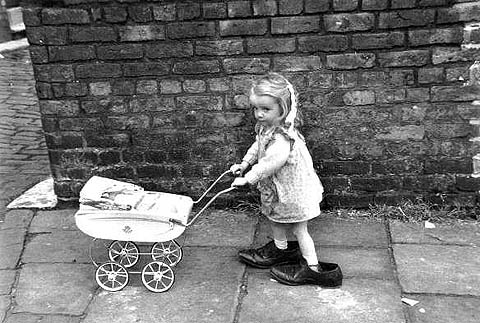 This
photograph is taken from Street
Photographs: Manchester and Salford Working every day with young children in Canada, I can see that the way they spend their leisure time very much reflects the time in which they live. Many of them have computers and televisions of their own, they have video game machines and telephones and that is where they spend their time. In my street only a few people had a TV and no one had a telephone. If I wanted to play a game or talk to a friend I had to go out on the streets to do it. Even sports are elaborate and organized these days. Kids play soccer, baseball, and hockey in organized leagues with practice schedules, regular competitive games, coaches, uniforms, and sports grounds. We took off our jackets and put them on the ground to make a goal and wrecked our good school shoes defending the honour of United against those City kids. What hasn't changed though is imaginative play. Kids still play tag and hide-and-seek and hopscotch but they also play role playing games and find entertainment in whatever is around. Today the trend in imaginative play is to mimic what is seen on TV, and right now in our school that usually involves WWF Wrestling. Children are pretending, and sometimes more than pretending, to act out the moves of their favourite wrestlers. It was much the same for us, except that we usually mimicked the things we saw at the pictures, and since most of the films of that era were either cowboys, war movies or period pieces about pirates, knights in armour or Tarzan, that was what we played. For ages after we saw Johnny Weissmuller swinging through the trees there was great competition for who got to be Tarzan, Jane and Cheetah. Cheetah was the most popular because you got to walk funny and make chimp noises. The toys we took out onto the street to play with were model soldiers, dinky toys, matchbox toys, and guns. The girls had dolls and prams and trolleys. We all played for hours on end until called in for a meal or bed or until we fell out and packed up our toys and went home. The croft and the grassed areas between the houses were great for playing with model cars and soldiers. Trenches could be built in the dirt and armies could sneak up on their enemy through the forest of grass and weeds. The dirt could be smoothed with a discarded lolly stick into roadways for the cars to drive. 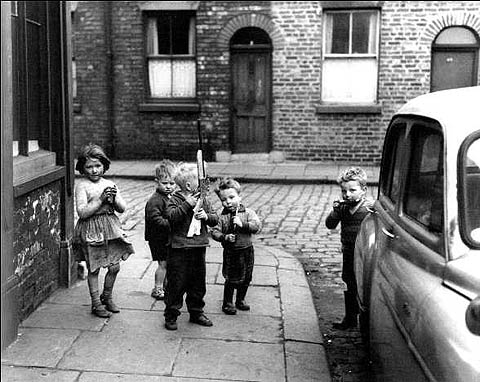
This
photograph is taken from Street
Photographs: Manchester and Salford An
unlimited supply of back entries and back yard
gates offered all sorts of possibilities for
Indians to ambush cowboys. I remember I got
this wonderful replica six gun with real fake
bullets and my Dad made me a leather holster
that tied down to my leg so I could do a fast
draw. Saturday matinee westerns spilled over
into the streets. One year I got a replica of
an old pirate pistol and, with a patch over
one eye, Blackbeard and "The Red Pirate"
sailed the cobbled seas of Longsight. *************************** In Longsight there were no trees for us to climb but we did have lamp posts and it was something of a measure of manhood or womanhood if you could climb them. The old ones that started out as gas lamps were pretty easy because they had such convenient ridges for your feet and a handy set of horizontal arms to reach for with your hands. The newer metal lamps were useless because the only thing you could do was shinny up them like a tree. There was a sort of sloping ledge to start your feet on, but then it was just several feet of tapered metal tubing and most people lost grip and strength and slid back down.  by Shirley Baker (Bloodaxe Books 1989) It is displayed here with the permission of the photographer The old lamps were also great for making swings on. Someone climbed up and tied one end of a heavy rope to the cross arms and then, holding the other end of the rope, you would run as fast as you could around the lamp. As the rope wrapped around the pole it shortened and you could lift your feet off the ground and spin around the pole. If you could find a tire you could tie it on the end and then you had a seat. Some people used a pillow or even a pullover to add a little comfort. Whilst skipping was exclusively a girls game, they were as usual, better at it than the boys who dared to join in. There were various games, with rules that were beyond most boys, and various speeds at which the rope was turned, pepper being the fastest. Sheglah Street remembers some of the rhymes that she and her friends used is the 50s.
Having lived in England and Canada and experienced both climates I can tell you that just as it gets much much colder here in the winter it also gets much much hotter in the summer. However, only in England have I ever seen the road surface actually melt in the summer. A few years back we went on a motoring holiday in the Dales and each morning as we left our cottage to go out for the day we drove along the pathway used by a herd of dairy cattle to reach the milking parlour. The road was always decorated with their droppings. As the day heated up the roads got decidedly sticky as the tar began to melt. I don't know who has that rental car now but I doubt it will ever rust. It has an undercoating of alternate layers of cow manure and tar encrusted forever to its underbody. In Longsight they covered over the cobbles with a tar surface and then rolled into it granite chippings. Every summer when it got hot (in those summers when it did get hot) the tar melted and we went digging. The tar would actually bubble up and the always available lollipop stick was great for popping them. Then, like eating spaghetti, we would twirl the pitch onto the stick. Of course the pitch rarely stayed on the stick it also found its way onto our hands, clothes, shoes and invariably our hair. Experience seemed to show that best butter was the only thing you could use to get pitch out of hair. A good hiding often brought the activity to a halt, at least until next year.
Longsight Station was a very popular venue for the boys. There were those of us who were trainspotters when it was still fashionable to be one, well before the time when trainspotters are regarded as middle-aged geeks with greasy hair and wearing anoraks. Even wearing an anorak was "cool" in the 1950's and early 1960's. For us the station offered an opportunity to add a few more numbers to our rough notebook so we could go home and underline the numbers in the official book. Just hanging out near the station gave you a chance to see the main line express locos that pulled trains like "The Pines Express" or "The Cornish Riviera" through the station. There was more adventure though to be found in risking capture by the feared railway police and going back into the sheds. Back in
that forbidden place there were other things
to explore. Close by the sheds were some
underground concrete shelters left over from
WWII. Because of our tropical climate the
shelters were usually at least ankle deep in
water but we still ventured down the steep
flight of steps to explore the darkness. A little further away was the reservoir which was, I suppose, a source of water for the steam boilers on the old trains. The reservoir was fenced in, off limits, and a very popular hang-out for kids. Gordon Galloway was there the day one youngster fell in and disappeared from sight. He remembers the police coming and one constable going in to search. He located the boy's body with his feet while treading water. He pulled him to the surface but it was too late to save him. The death of that boy was used by every mother in Longsight as an example to keep their sons away, but like kids anywhere we went back anyway. In the sidings near the station open wagons from the Derbyshire quarries often sat with their loads of stone chips destined for a road surface somewhere. This gave the boys who hung around the station a wonderful environment into which to extend the war games. With pockets bulging with stones we used the wagons as cover and fought off the enemy with a hail of stones. 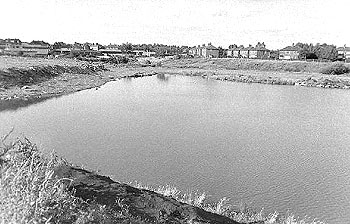 Another popular place to play, especially on hot summer days was Jackson's Clay Pit. Another place we were told never to go (Picture right donated by Les Cotton) Les said: "....pic of Jackson's Claypit, top of East Rd. with Pink Bank Lane to the left, looking towards Mount Rd., Gorton. I guess this is the border between Longsight and Gorton. We used to have great fun as kids riding down the "Coal hills". Its all filled in and built on now." The pictures below, generously donated by Susan (Chester) Dickert, show friends, sisters and a brother beside the fence around Jackson's Clay Pit. If you look carefully in the first two pictures from the left you can see a small clay truck in among the weeds. 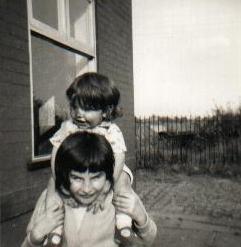
 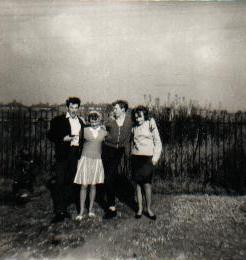 It would be wrong to suggest that every Longsight childhood in the 1950's was some sort of idyllic time free from worry and hardship. It would also be wrong to portray the time as innocent and crime free. We have to remember that one of the children who fell victim to Ian Brady and Myra Hindley was a pupil at Plymouth Grove School. However, it was time when children played in relative safety on the streets and a time of community, when kids played in gangs but the term gang described a social group rather than a criminal organization.  Shelagh Street describes
it thus: "The high life c. 1956 potted
meat sandwiches, crisps, butterfly cakes
and jelly followed by Dandelion and
Burdock or Vimto."
- Organized Groups - 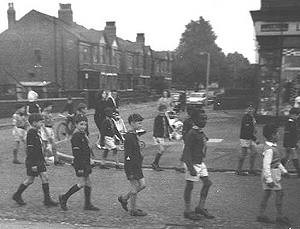 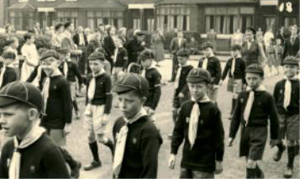 Left: A younger Les Cotton posing for the camera (Second last) Right: A photograph donated by Graham Todd who describes it as follows: "In the lower photo, I am second from the left in the nearest rank, followed by Norman Hallsworth, who is followed by his younger brother Raymond. Robert Arnold is in the middle rank, facing the camers second from left." 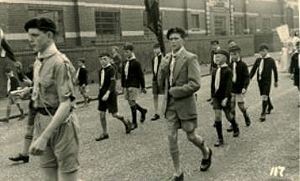 Above: Photograph donated by Graham Todd. Graham says, "Northmoor Road Whitweek parade passing the old Co-op laundry on Hemmons Road, on its way back to Bickerdike and Northmoor Road. In the middle rank between the two scouts is Robert Arnold facing the camera, with me staring ahead trying to avoid the camera, following behind. Immediately behind the flag bearer is Ian Lees, also of Santley Street. ************************** I want to thank Shirley Baker for giving me permission to display her photographs on this page. The images are taken from a wonderful book called "Street Photographs: Manchester and Salford". The book is an amazing collection of images of Salford and Manchester during the period 1960-1973. Like no other photographs I have seen of our cities, these images capture the soul of the twin cities during that period. Not just a record of streets and buildings, Shirley's photographs have captured the spirit of people living in dreadful conditions and finding something to laugh about.
|


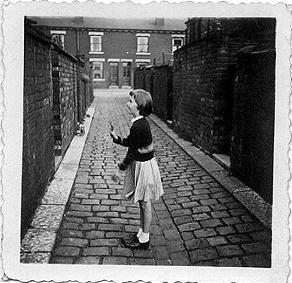
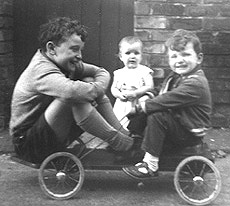 Longsight
was
as
flat as a pancake so it's hard to understand why
bogies were so popular. It wasn't as if we could
do the old soap-box derby thing, where we raced
down hill in these unpowered wooden carts. I
suppose the best part was building them from the
wheels off abandoned trolleys or prams and scrap
timber. I remember my Dad built me one that was
the Rolls Royce of bogies with all sorts of
refinements like footrests, a comfortable
sitting area and brakes. Usually they were
stopped by putting your feet on the tires or the
Fred Flintstone way with your feet dragging on
the ground. We propelled them by having someone
push you by hand or with a pushing pole. The
were steered with a string attached to the
movable front wheels. Bogies became your
constant companion and running errands became a
pleasure not a chore because you could take your
bogie to bring the groceries home on. Having a
bogie was a status symbol.
Longsight
was
as
flat as a pancake so it's hard to understand why
bogies were so popular. It wasn't as if we could
do the old soap-box derby thing, where we raced
down hill in these unpowered wooden carts. I
suppose the best part was building them from the
wheels off abandoned trolleys or prams and scrap
timber. I remember my Dad built me one that was
the Rolls Royce of bogies with all sorts of
refinements like footrests, a comfortable
sitting area and brakes. Usually they were
stopped by putting your feet on the tires or the
Fred Flintstone way with your feet dragging on
the ground. We propelled them by having someone
push you by hand or with a pushing pole. The
were steered with a string attached to the
movable front wheels. Bogies became your
constant companion and running errands became a
pleasure not a chore because you could take your
bogie to bring the groceries home on. Having a
bogie was a status symbol. As we got older we were
allowed to wander farther afield beyond the
confines of "the street", and that usually
meant going to the Sand Park or Longsight
Station. Typical trips usually involved a
small gang of kids and sometimes ended up in
mischief.
As we got older we were
allowed to wander farther afield beyond the
confines of "the street", and that usually
meant going to the Sand Park or Longsight
Station. Typical trips usually involved a
small gang of kids and sometimes ended up in
mischief.